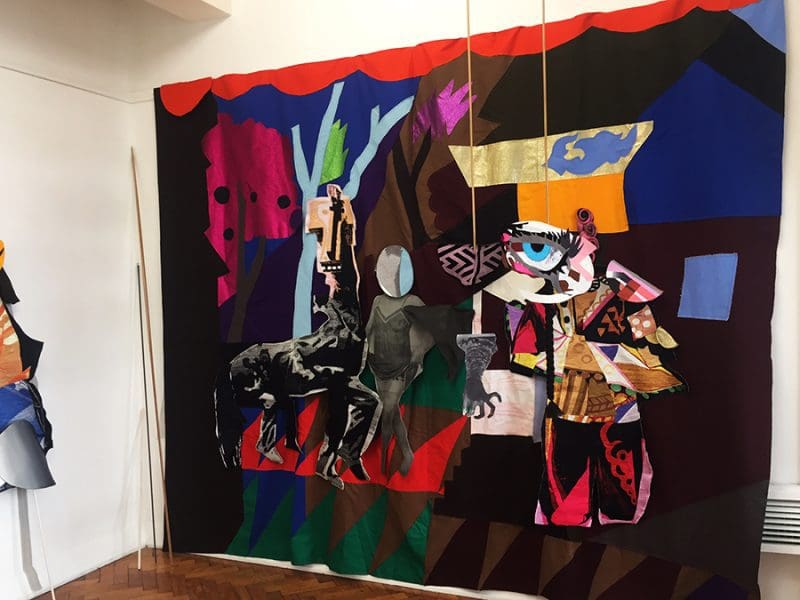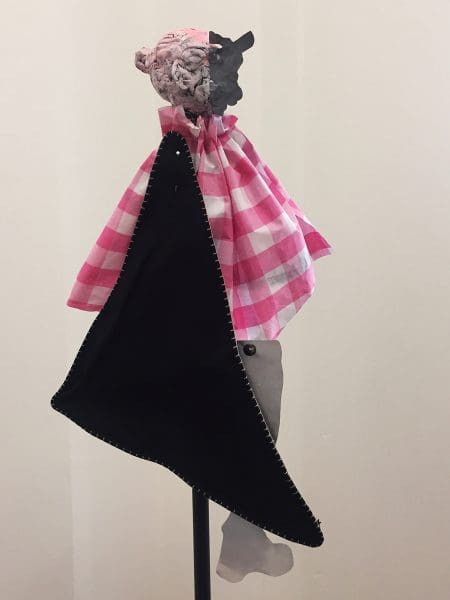
Place-driven Practice
Running for just two weeks across various locations in greater Walyalup, the Fremantle Biennale: Sanctuary, seeks to invite artists and audiences to engage with the built, natural and historic environment of the region.




In her solo show, The Choreography of Cutting, Sally Smart has effectively traced her ongoing commitment to an investigation into three seemingly disparate topics: the historical Avant-Garde, traditional Indonesian folk art and the act of cutting. In theory, any attempt to synthesise the three with ease would seem like a stretch. However, Smart has created a convincing exhibition, revealing points of contact in unpredictable yet organic ways.
Smart’s interest in Indonesian art and culture (she now has a permanent studio in Yogyakarta where she works with a team of assistants) finds strong, unforced footing among references to the historical Avant-Garde. Performance/Punokawan (Chout Rehearsal), 2017, a magnificent amalgamation of tapestry, collage elements and paint directly applied to the wall, can trace its origins to the early 20th century Ballets Russes. At the centre of the work is a tapestried costume comprised of several original designs from Mikhail Larionvo’s costumes for the 1921 production of Chout that have been subsequently digitally cut-up and rearranged to create a single outfit. Smart has taken pains to simulate a feeling rather than to create a true representation of the original. In the foreground, an aluminium cut-out of a Javanese dancer’s hand is suspended from the ceiling, quietly inserted into this mise en scène to remind its viewer of the non-western origins of many elements of these costumes. In this way, Smart upsets the image of Avant-Garde artists as absolute creators, while nonetheless continuing to subscribe to a romantic conception of their practice, albeit updated through a contemporary lens.
Entering a second room at Sarah Scout Presents, the viewer is confronted with The Choreography of Cutting (The Pedagogical Puppet Projects), 2017. Here, Smart has again used various historical and cultural references, but this time her investigation of movement is process-based. A large black canvas scrawled with quotes from the likes of Gertrude Stein, Pina Bausch and Rudolph von Laban covers two walls of the space. In the creation of this piece Smart used a process that necessitated the entire body: reaching, bending and moving across the length and height of the canvas: she has inevitably acted out the topic of investigation.
In one corner, a video work titled Hannah/Martha (Pedagogical Puppet Projects), 2016-2017, depicts a study in choreography created with the use of puppets and shadows: a hybrid between the flat Indonesian shadow puppet technique and a more Western style of doll. Here, Smart decentres Eurocentric notions of performance to give greater consideration to bodily movement on a universal scale.

Cutting is evident in various forms in The Choreography of Cutting (The Pedagogical Puppet Projects). Metaphorically, the quotes used by Smart have been ‘cut’ from their original contexts. Further, the use of collage (in this particular piece, photographs of choreographers from history layered with hair and tapestry) harks back to Dada collages and the cutting that was required in their creation. Both approaches play with the concept of the rearrangement of context.
Entering the final room, the viewer encounters a large digital photograph of Smart with a puppet, hanging alongside two large textile collages of Hannah Höch, and a small puppet of clay and textile atop a long steel pole entitled Punokawan Puppet, 2017. This ‘puppet hang’, considers simultaneous histories beginning with Hannah Höch’s Dada Puppen (which fed into a number of Avant-Garde doll artworks, such as Hans Bellmer’s creepy disfigured mannequins) in conversation with the other pieces influenced by Smart’s study of Indonesian art.
Ultimately, the viewer is presented with a consideration of language. Certain cues must be used to allow us to identify the context from which these works have been derived. The Punokawan, for instance, is adorned with pink and white checked fabric that is at odds with the traditional Indonesian textiles we might expect. However, this puppet also maintains a general form that is seen in the video in the previous space. These works demonstrate the conversation that is happening between all the works in Smart’s exhibition, and, indeed, her oeuvre. Smart is just as interested in keeping a tradition of aesthetics alive as she is in breaking down the boundaries that dictate what contemporary art can be.
The Choreography of Cutting
Sally Smart
Sarah Scout Presents
11 March – 15 April